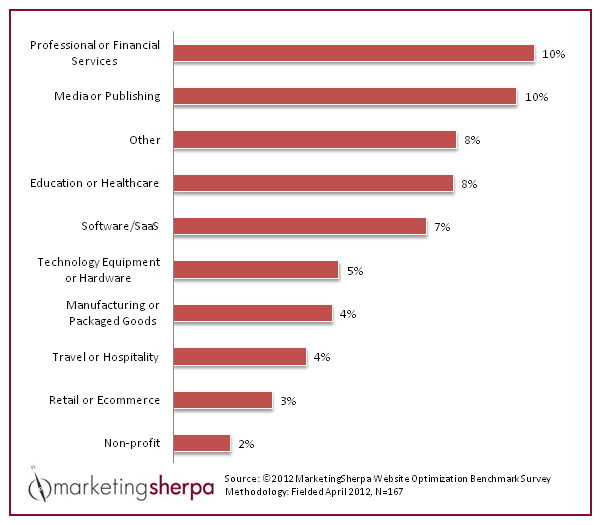
|
SUMMARY:
No matter what channels you utilize -- from email marketing to social media to print advertising -- the call-to-action often leads to a website where an actual conversion, be it generating a lead or completing a sale, occurs. |
by Daniel Burstein, Director of Editorial Content
In the following chart, from the MarketingSherpa 2012 Website Optimization Benchmark Report, we look at average conversion rates broken down by industry.
Q. Please write in your organization's average conversion rate.

Click here to see a larger, printable version of this chart
Please Note: Bars with the same percentage don’t always line up, because the number has been rounded off, while bar length represents the exact answer.
What are your other thoughts on this data? Share your own analysis in the MarketingSherpa LinkedIn Group for a chance to be published in a future blog post. Include your feedback as either a comment or a link to a blog post where you offer advice based on this data.
Here are a few points to consider as you evaluate this data …
There are many possibilities for the variability of conversion rate performance among the different industries in the above chart. There are certainly many reasons for this disparity, ranging from customer motivation to promotional budgets to marketing channels used.
However, another likely difference is the very definition of conversion rate. A conversion rate can refer to any goal a marketer has, from the sale of a product to a lead form fill, newsletter subscription or free-trial software download.
Perhaps, in the above chart, financial services firms' main conversion goal is simply an email address for a lead in exchange for a free e-book or print publication, and media websites might only be looking for a free newsletter subscription. Whereas, nonprofits might be focused on a much harder conversion goal to attain -- a cash payment in exchange for an idea of doing good, which requires a much higher commitment on the part of the customer and much less obvious concrete value.
What are your conversion goals for your website, and how do they affect your conversion rates? Do you adjust your conversion rate expectations based on the commitment required from the customer and the value given in exchange for that commitment?
Some marketers use benchmark data to compare their own organization’s performance to industry averages to gain buy-in and budget approval from senior marketing management and business leaders, and to apprise the entire organization of their team’s performance.
Others simply eyeball benchmark data, using it less as an official yardstick of their performance, and more as a general ballpark of where they would like their performance to lie.
Still, others dismiss benchmark data out of hand, simply focusing on their own company’s previous performance in a vacuum.
How do you use benchmark data? What are the benefits and downsides of using such information? Has comparing performance to benchmark data improved your ability to gain budget approval, influence and political capital in your organization?
Use these discussion questions to gain value out of this marketing research data by discussing these and other pressing issues with your team and your agency (and feel free to share your insights with the MarketingSherpa community, as well).
For three more key findings from our research, download a free excerpt from the MarketingSherpa 2012 Website Optimization Benchmark Report (there is no squeeze-page form fill required, this is an instant download).
MarketingSherpa Quick Guide to Conversion Rate Optimization
Email Optimization: 72% of marketers test subject lines
Lead Generation: 81% of marketers use email marketing
Email Marketing: 83% of CMOs says social media will affect email programs
Get Better Business Results With a Skillfully Applied Customer-first Marketing Strategy

The customer-first approach of MarketingSherpa’s agency services can help you build the most effective strategy to serve customers and improve results, and then implement it across every customer touchpoint.
Get More Info >MECLABS AI

Get headlines, value prop, competitive analysis, and more.
Use the AI for FREE (for now) >Marketer Vs Machine

Marketer Vs Machine: We need to train the marketer to train the machine.
Watch Now >Free Marketing Course

Become a Marketer-Philosopher: Create and optimize high-converting webpages (with this free online marketing course)
See Course >Project and Ideas Pitch Template

A free template to help you win approval for your proposed projects and campaigns
Get the Template >Six Quick CTA checklists

These CTA checklists are specifically designed for your team — something practical to hold up against your CTAs to help the time-pressed marketer quickly consider the customer psychology of your “asks” and how you can improve them.
Get the Checklists >Infographic: How to Create a Model of Your Customer’s Mind

You need a repeatable methodology focused on building your organization’s customer wisdom throughout your campaigns and websites. This infographic can get you started.
Get the Infographic >Infographic: 21 Psychological Elements that Power Effective Web Design

To build an effective page from scratch, you need to begin with the psychology of your customer. This infographic can get you started.
Get the Infographic >Receive the latest case studies and data on email, lead gen, and social media along with MarketingSherpa updates and promotions.